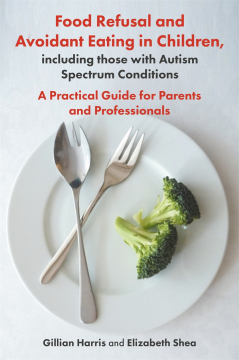
BOOK
Food Refusal and Avoidant Eating in Children, including those with Autism Spectrum Conditions
Gillian Harris | Elizabeth Shea
(2018)
Additional Information
Book Details
Abstract
Many children with Autism Spectrum Disorder (ASD) have a restricted dietary range, and this book provides parents with advice and training on how to deal with this condition and achieve a healthier and more balanced diet. Now described as Avoidant or Restrictive Food Intake Disorder (ARFID), it is due to sensory hypersensitivity, and it can impact upon the health of the child, upon the family, and upon social integration.
Based upon successful training packages the authors provide for parents and professionals, this book enables the reader to understand the condition and work with it, gradually increasing the range of food a child is able to eat. It includes 'box outs' with case studies, points of interest and action points to make this an accessible and resourceful read.
Harris and Shea have produced a fantastic resource for parents and professionals alike. Not only does this book give great advice to help children with food refusal and avoidant eating, but also covers the evidence base about the reasons underlying these behaviours in an accessible and enlightening way.
Prof. Jackie Blissett, Professor of Childhood Eating Behaviour, Aston University, UK
An important book full of information for professionals and parents who deal with 'fussy eaters' (many of them are on the autism spectrum). A useful read if you want to learn more about why some children (and adults) have problems related to food and the best strategies to successfully manage this.
Olga Bogdashina, author, lecturer in Autism Studies, co-founder of the International Consortium of Autism Institutes
Dr Gillian Harris has worked for over 35 years, both in research and as a clinician, almost exclusively with children with food refusal behaviours.
Dr Elizabeth Shea has worked as a clinician for 20 years both with children with autism and children with food refusal behaviours.
Table of Contents
| Section Title | Page | Action | Price |
|---|---|---|---|
| Food Refusal and Avoidant Eating in Children, including those with Autism Spectrum Conditions - A Practical Guide for Parentsand Professionals | 3 | ||
| Acknowledgments | 6 | ||
| Contents | 7 | ||
| Introduction | 9 | ||
| Part1 - Acceptance and \nRejection of New Foods in Infancy and Childhood: Development Stages | 15 | ||
| Chapter 1 - The Early Stages | 17 | ||
| Chapter 2 - Neophobia: The Onset of the Fear of New and Different Foods | 34 | ||
| Chapter 3 - Sensory Factors and How These Affect Food Acceptance | 51 | ||
| Chapter 4 - The Disgust Response and the Development of Avoidant Eating | 64 | ||
| Chapter 5 - Appetite and Appetite Regulation | 79 | ||
| Chapter 6 - What Is Avoidant and Restrictive Food Intake Disorder? | 95 | ||
| Part 2 - Avoidant and Restrictive Eating: Strategies and Interventions | 111 | ||
| Chapter 7 - Managing the Environment around the Child | 113 | ||
| Chapter 8 - Is the Child Ready to Move On? | 126 | ||
| Chapter 9 - What Doesn’t Work and Why | 139 | ||
| Chapter 10 - Interventions with the Younger Child | 153 | ||
| Chapter 11 - Interventions with the Older Child | 175 | ||
| Chapter 12 - What Else Might Be Going Wrong? | 195 | ||
| Final Words | 211 | ||
| Bibliography | 212 | ||
| Resources | 221 | ||
| Index | 223 | ||
| Blank Page |
